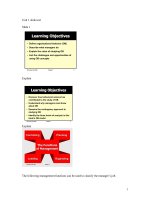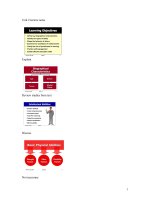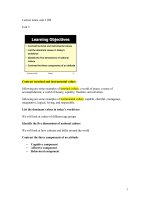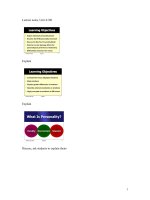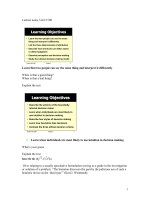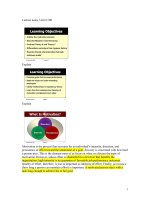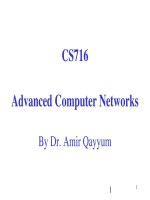Organizational behavior: Lecture 38 - Dr. Mukhtar Ahmed
Bạn đang xem bản rút gọn của tài liệu. Xem và tải ngay bản đầy đủ của tài liệu tại đây (820.85 KB, 38 trang )
Organizational
Behavior
(MGT-502)
Lecture-38
Summary
of
Lecture-37
Organizational
Change
Change or
Disappear
Forces For Change
External Forces
• Economic Forces
• Technology
• Social and
Political Change
• Process
• Behavioral
Internal
Forces
Types of Change
Planned
Unplanned
Evolutionary
Revolutionary
Today’s Topics
Rate of Technological Change
2,500,000 B.C.
1,000,000 B.C.
2,000 A.D.
Resistance To Change
Individuals
Habit
Fear of unknown
Economic threat
New social relationships
Dislike of change agent
Dislike of implied criticism
Organizations
Threats to power
Resource limitations
Fixed investments
Driving Forces
Changing technology
Knowledge explosion
Rapid product obsolescence
Changing nature of workforce
Changing values
Overcoming Resistance
Coercion
Resist
Manipulation
Negotiation
Tolerate
Education
Participation
Facilitation
& Support
Accept
Support
Minimizing Resistance to
Change
Communication
Coercion
Negotiation
Training
Minimizing
Resistance
to Change
Stress
Management
Employee
Involvement
Managing Organizational
Change
The Three C’s of Change
• Customers take charge
• Competition intensifies
• Change becomes constant
A continuous challenge as
customer expectations
change and can sometimes
change faster than
organizations can respond
The New World of Work
• Peoples’ roles change - from controlled to
empowered
• Job preparation changes - from training to
education
• Focus of performance measures and
compensation shifts - from activities to results
• Advancement criteria change - from protective to
productive
• Managers change - from supervisors to coaches
• Organization structures change - from
hierarchical to flat
• Executives change - from scorekeepers to
leaders
Change Can Be….
•
•
•
•
•
Huge, catastrophic
Predictable
Positive
Productive
A small modification
to your life
• Taken in stride, managed
•
•
•
•
•
Small, incremental
Unpredictable
Negative
Unproductive
A devastating collapse
of your world
• Continuously stressful
Some External Forces for
Change
Information
Technology
Globalization
& Competition
Demography
• Easier information transfer
• Facilitates global structures
• Requires new competencies
and expectations
• Facilitates telecommuting;
new employment
relationships
• More emphasis on
knowledge management
Some External Forces for
Change
Information
Technology
Globalization
& Competition
Demography
• Global competition
• Technology makes it easier
to compete quickly
• Results in restructuring,
outsourcing, mergers
– produces many employment
changes
Some External Forces for
Change
Information
Technology
Globalization
& Competition
Demography
• More educated workforce
– want involvement; interesting work
• Younger generation
– less intimidated by status
– want a more balanced work life
• Cultural changes
– more individualism in traditionally
collectivist countries
Areas Where Change Can
Occur
• Change Technology
• Change the Organization’s Structure
or Design
• Change Job Responsibilities or tasks
performed
• Change People
Change Management Concept Model
Strategy
Organizational Structure
Business Models/Systems
Business Processes
People
Change Management Success
Factors
People
Business Processes
Business Models/Systems
Organizational Structure
Strategy
Change Management Risk Alignment
People
Business Processes
Business Models/Systems
Organizational Structure
Strategy
The Change Agent’s Role
Change agent - the individual
or group who undertakes the
task of introducing and
managing a change in an
organization
The change agent can be internal or external

